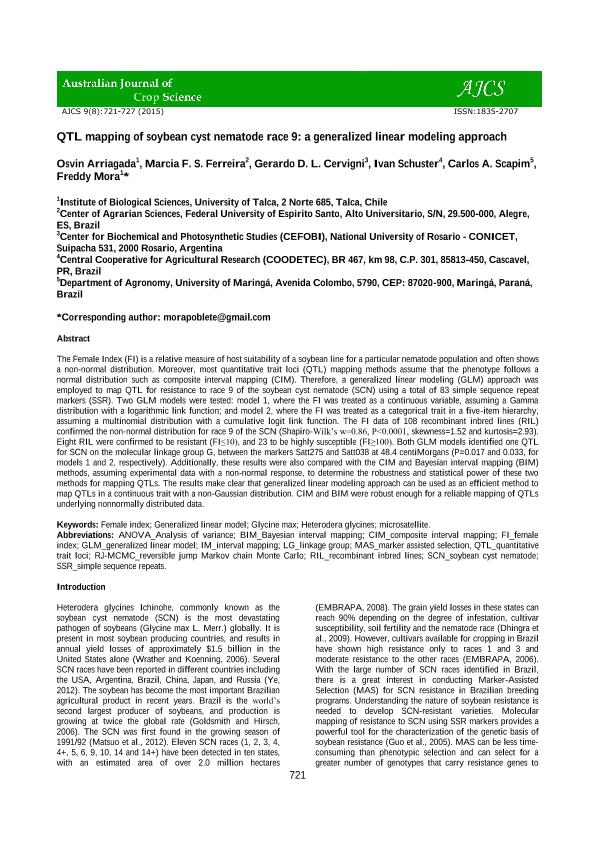Mostrar el registro sencillo del ítem
dc.contributor.author
Arriagada, Osvin
dc.contributor.author
Ferreira, Marcia F. S.
dc.contributor.author
Cervigni, Gerardo Domingo Lucio

dc.contributor.author
Schuster, Ivan
dc.contributor.author
Scapim, Carlos A.
dc.contributor.author
Mora, Freddy
dc.date.available
2016-10-27T21:20:41Z
dc.date.issued
2015-08
dc.identifier.citation
Arriagada, Osvin; Ferreira, Marcia F. S.; Cervigni, Gerardo Domingo Lucio; Schuster, Ivan; Scapim, Carlos A.; et al.; QTL mapping of soybean cyst nematode race 9: a generalized linear modeling approach; Southern Cross Publ; Australian Journal Of Crop Science; 9; 8; 8-2015; 721-727
dc.identifier.issn
1835-2693
dc.identifier.uri
http://hdl.handle.net/11336/7843
dc.description.abstract
The Female Index (FI) is a relative measure of host suitability of a soybean line for a particular nematode population and often shows a non-normal distribution. Moreover, most quantitative trait loci (QTL) mapping methods assume that the phenotype follows a normal distribution such as composite interval mapping (CIM). Therefore, a generalized linear modeling (GLM) approach was employed to map QTL for resistance to race 9 of the soybean cyst nematode (SCN) using a total of 83 simple sequence repeat markers (SSR). Two GLM models were tested: model 1, where the FI was treated as a continuous variable, assuming a Gamma distribution with a logarithmic link function; and model 2, where the FI was treated as a categorical trait in a five-item hierarchy, assuming a multinomial distribution with a cumulative logit link function. The FI data of 108 recombinant inbred lines (RIL) confirmed the non-normal distribution for race 9 of the SCN (Shapiro-Wilk?s w=0.86, P<0.0001, skewness=1.52 and kurtosis=2.93). Eight RIL were confirmed to be resistant (FI≤10), and 23 to be highly susceptible (FI≥100). Both GLM models identified one QTL for SCN on the molecular linkage group G, between the markers Satt275 and Satt038 at 48.4 centiMorgans (P=0.017 and 0.033, for models 1 and 2, respectively). Additionally, these results were also compared with the CIM and Bayesian interval mapping (BIM) methods, assuming experimental data with a non-normal response, to determine the robustness and statistical power of these two methods for mapping QTLs. The results make clear that generalized linear modeling approach can be used as an efficient method to map QTLs in a continuous trait with a non-Gaussian distribution. CIM and BIM were robust enough for a reliable mapping of QTLs underlying nonnormally distributed data.
dc.format
application/pdf
dc.language.iso
eng
dc.publisher
Southern Cross Publ

dc.rights
info:eu-repo/semantics/openAccess
dc.rights.uri
https://creativecommons.org/licenses/by-nc-sa/2.5/ar/
dc.subject
Female Index
dc.subject
Generalized Linear Model
dc.subject
Glycine Max
dc.subject
Heterodera Glycines
dc.subject.classification
Agricultura

dc.subject.classification
Agricultura, Silvicultura y Pesca

dc.subject.classification
CIENCIAS AGRÍCOLAS

dc.title
QTL mapping of soybean cyst nematode race 9: a generalized linear modeling approach
dc.type
info:eu-repo/semantics/article
dc.type
info:ar-repo/semantics/artículo
dc.type
info:eu-repo/semantics/publishedVersion
dc.date.updated
2016-03-14T12:49:50Z
dc.identifier.eissn
1835-2707
dc.journal.volume
9
dc.journal.number
8
dc.journal.pagination
721-727
dc.journal.pais
Australia

dc.description.fil
Fil: Arriagada, Osvin. Universidad de Talca; Chile
dc.description.fil
Fil: Ferreira, Marcia F. S.. Universidade Federal Do Espirito Santo; Brasil
dc.description.fil
Fil: Cervigni, Gerardo Domingo Lucio. Consejo Nacional de Investigaciones Científicas y Técnicas. Centro Científico Tecnológico Rosario. Centro de Estudios Fotosintéticos y Bioquímicos (i); Argentina
dc.description.fil
Fil: Schuster, Ivan. Central Cooperative for Agricultural Research; Brasil
dc.description.fil
Fil: Scapim, Carlos A.. Universidade Estadual de Maringá; Brasil
dc.description.fil
Fil: Mora, Freddy. Universidad de Talca; Chile
dc.journal.title
Australian Journal Of Crop Science

dc.relation.alternativeid
info:eu-repo/semantics/altIdentifier/url/http://www.cropj.com/arriagada_9_8_2015_721_727.pdf
Archivos asociados
